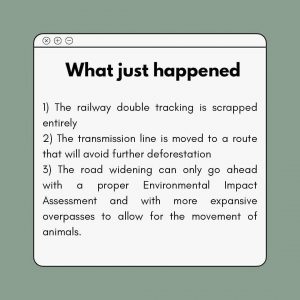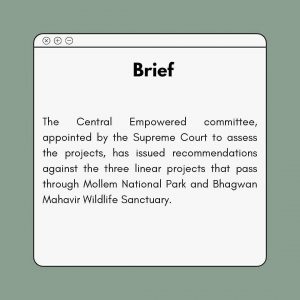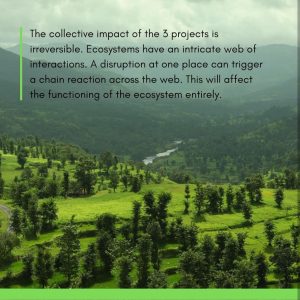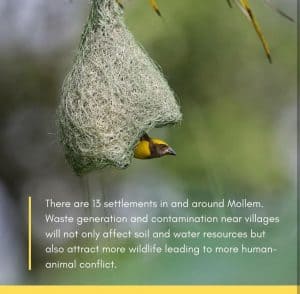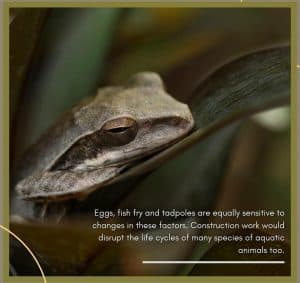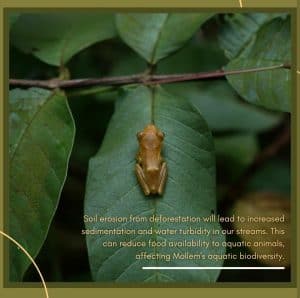Update 27th April 2021: CEC comes to rescue of Mollem forest
Read article here: https://www.heraldgoa.in/Goa/CEC-comes-to-rescue-of-Mollem-forest/174164
Citizen’s Toolkit for Mollem
What’s going on – details of the three proposed projects
There are three infrastructure projects that threaten the forests in and around Mollem
National Park and Bhagvan Mahaveer Wildlife Sanctuary. In the middle of the lock-down the
National Board for Wildlife cleared or discussed more than 30 forest clearance proposals. Of
these 2 projects from Bhagwan Mahaveer Wildlife Sanctuary/Mollem National Park, Goa
were cleared virtually by the National Board for Wildlife.
What are the three projects?
(To help you visualise, a hectare (ha) is roughly 1 1⁄2 times the size of an average football
field.)
1. Four-lane highway expansion
(Total forest land required – 63.615 ha;
Total number of trees to be felled are 20,340; of which 12,097 trees will be felled from
the protected area). Cost of project 1794 CR.
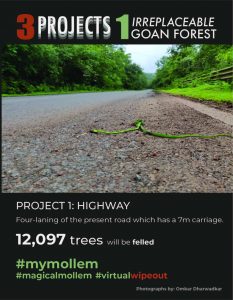
2. Double tracking the railway line
(Total forest land required- 138.37 ha;
Total number of trees to be felled are 22,882; of which 20,758 will be felled from the
protected area). Cost of project 504 CR.
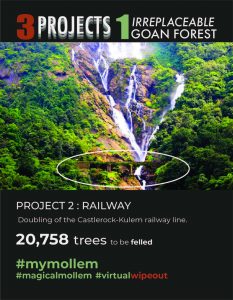
3. Laying a 400kv transmission line
(Total forest land required – 48.3 ha;
Total number of trees to be felled are 15,772; of which 4139 trees will be felled from
the protected area). Cost of project Rs 176.8 CR.
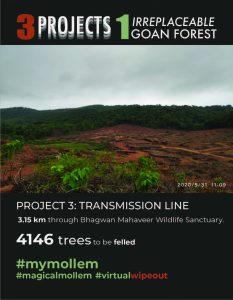
For the Goans, to put it in perspective, the amount of land that will be cleared
by all three projects (250.3 ha) is roughly 370 times the area of Fatorda’s
Jawaharlal Nehru Stadium.
So far there have been six proposals submitted (two forest clearance proposals for NH-4A;
three forest clearance proposals for railways and one proposal for the transmission line)
which amount to a diversion of 250.285 hectares where 59,024 trees will be felled in and
around Bhagwan Mahaveer Wildlife Sanctuary and Mollem National Park. Specifically with
respect to the protected area, 170 hectares are planned for forest diversion.
Project I:
4 laning NH 4A The National Highway 4A connects the state of Goa and Karnataka, running from Belgavi to Panaji, and is about 153 km in total length. Of this, 83 km falls within Karnataka (km 1-83) and about 70.075 km falls within Goa (km 84-153.075). 13 km of the highway in Goa, beginning at the state border, falls within the Bhagwan Mahaveer Wildlife Sanctuary and Mollem National Park. In Karnataka, the work of widening the NH 4 A is being carried out by the NHAI and by the PWD in Goa.
At present the road passing through the protected area is a wide double lane road having a carriageway of 7m, and RoW (right of way) of 12 m. The proposal to widen the highway within the protected area seeks to widen the existing double lane highway into a 4 lane highway with a total carriageway of 14 m and RoW of 26 m, largely by creating completely new roads held up on viaduct structures. The proposal therefore involves not just widening of certain sections but creating a new highway on viaducts in pristine and hitherto untouched parts of the wildlife sanctuary and national park. This proposal involves the cutting of 12,097 trees and the diversion of about 31.015 ha. of protected forest area (24.265 in the National Park and 6.75 in the WLS). The estimated cost of the project is Rs. 59400 lakhs. The objectives of the proposal, as stated in the application, are to “meet the increased demands of traffic in the area and to reduce travel time, fuel requirements and pollution.”
Project II:
Doubling of railway line
The second project is the Castlerock – Kulem Railway Doubling. This project is part of the larger Hospet-Tinaighat-Castelrock-Kulem-Vasco Railway doubling project being
undertaken by the M/s Rail Vikas Nigam Limited (RVNL). The total length of the line is 345 km. The railway line passes through the sanctuary in two parts and two separate proposals have been submitted. The first proposal is for the part from Castlerock to Kulem and the second for a part from Kulem to Madgaon. Castlerock forests are part of Dandeli-Anshi Tiger Reserve (DATR), in Karnataka, while forests between the Goa-Karnataka border and Kulem fall within the Bhagawan Mahaveer Wildlife Sanctuary (BMWLS) in Goa. As per the application for Wildlife approvals, this project involves the diversion of 20,758 trees to be felled. Four underpasses measuring 12 m in width and 5.65 m in height have been proposed as mitigation measures.
Project III:
Laying of LILO of one CKT of Narendra (existing) – Narendra (new) 400 kV D/C quad transmission line at Xeldem
The thirdd project is a part of the 400 kV D/C Narendra (Karnatka) – Xeldem (Goa) Transmission Line which starts at Narendra village in Dharwad District, Karnataka and terminates at 400/220 kV substation at Xeldem in Goa. The project is being carried out by M/s Goa- Tamnar Transmission Project Ltd (Sterlite Power)
About 3.15 km of the transmission line is proposed to be constructed through the Bhagwan Mahaveer Wildlife Sanctuary. As per the application, the line would be 46 mtr in width, requiring a diversion of 11. 54 HA of area from the wildlife sanctuary and involves the cutting of 4139 trees. The estimated cost of the project is Rs. 5.58 Crores and the Construction of approach road to establishment of 2*500 MVA 400/220 KV Sub station costed 171.22 crores.
Map of the three proposed projects with the Protected Area. Credits: Technology for Wildlife
Why Mollem is Magical
The Western Ghats, of which Goa’s largest protected area is a part, are 150 million years old! They are older than the Himalayas. The forests are truly IRREPLACEABLE. There are only 36 biodiversity hotspots in the world and the forests of the Western Ghats is one of them. Goa lacks land and resources to carry out compensatory afforestation on such a scale. One mature tree absorbs around 22 kilos of CO2 each year, while a young tree can only absorb 6 kilos/ year. Felling 59,000 trees will create a massive impact in this regard. These forests streams feed Goa’s lifeline – River Mandovi – the foremost source of potable water.
What is at stake?
Few things to talk when spreading awareness/reaching out or using in your letter:
The three projects pose an immediate risk to:
The Intergovernmental Panel on Climate Change (IPCC) Report 2019 found that the Western Ghats is one of the most resilient ecosystems to climate change when they did a 1.5 degree impact assessment. This is extremely important as very few ecosystems are resilient to climate change and global warming). Maintaining the integrity of the Western Ghats allows Goa to have better adaptation strategies to deal with climate change. Hundreds of wildlife species including Schedule-I & Schedule-II endangered species such as the tiger (Panthera tigris), dhole (Cuon alpinus), mouse deer (Moschiola indica), gaur (Bos gaurus), and Indian Pangolin (Manis crassicaudata) will be threatened. The sanctuary is also home to more than 70 mammal species, 235 bird species, 219 butterfly species, 44 fish species, 45 reptile species, 27 amphibian species, 80 odonate species, 75 ant species, 721 plant species, at least 43 fungi species and 18 lichen species. Many of which are endemic (i.e not found anywhere else in the world) to the Western Ghats. The fragmentation of this wildlife corridor (the three projects cut through different areas of the national park) will INCREASE cases of human and wildlife conflict. Dudhsagar is one of the tallest waterfalls (310 mts) of India and this forest is an important revenue source for nature-based tourism. Along with Dudhsagar, hundreds of river feeders originate in this forest and are the lifeline for the state’s water supply. An estimated 42,340 animals become roadkill in Goa each year – how many more will become roadkill with a four lane highway?
Know the laws: Know the laws so that when you appeal to The Central Empowered Committee, National Board for Wildlife (NBWL) and The Chief Wildlife Warden (whose final signature is required to start these projects) your case stands strong.
Two important laws in The Wild Life (Protection) Act, 1972 that directly affect Bhagwan Mahaveer Sanctuary & Mollem National Park are Section 29 & Section 35 (6). It says that no destruction whatsoever can be made to the land and waterways of any wildlife sanctuary/national park unless it is for the improvement and better management of the wildlife therein.
What the government needs to address:
The National Highway 4A is a highway with a total length of 153 km. The entire stretch of 153 km is planned to be expanded across two states. A highway project where expansion work is undertaken for more than 100km involving additional right of way greater than 40 m falls under the Environment Impact Assessment (EIA) Notification, 2006 for which prior Environment Clearance is required from the MoEFCC.
Thus, conducting an EIA study following the EIA Guidance Manual for highways is must. The Guidance Manual states that the project proponent should collect primary baseline data (from the right of way and 500 meters on either side) and secondary data within a 15 km aerial distance.
But the NH-4A road expansion project has been split into two sections (83 km in Karnataka and 70.07 km in Goa) to evade the scrutiny of the EIA Notification, 2006.
In fact the Karnataka High Court in W.P 3350/ 2019 vide order dated 24th February, 2020 in a PIL filed against the NH-4A expansion work in the State of Karnataka noted that the “length of NH-4A which is taken up for widening may be more than 100 Kilometers stretching over Karnataka and Goa. If that be so, it cannot be said that widening is undertaken for the length which is less than 100 Kilometers.”
Thus, a fresh EIA study for the entire stretch should be conducted. The general conditions under the EIA Notification, 2006 also mandates project appraisal at the Central Level when any project is located within 5 km boundary of protected area, notified Eco Sensitive Areas and located in inter-state boundaries.
Cumulative impact assessment:
The three planned projects involve diversion of a total of 250 ha of forest land and felling of 59,000 trees from the notified Wildlife Sanctuary, National Park, Eco Sensitive Areas of the Western Ghats.
Further, seven forest clearance proposals have been submitted for execution of three projects within the State of Goa. All seven proposals are considered in isolation, there is no mention of the cumulative impacts for the execution of the three projects in one protected area. Thus, conducting a cumulative Environmental Impact Assessment of the all the three projects to understand the magnitude of Environmental impact of projects of national importance passing through the Western Ghats, a UNESCO World Heritage site is all the more important.
Due process:
The projects were passed on the basis of a virtual clearance (basically over a video call) that should be reconsidered and be held in abeyance until pandemic-related travel restrictions are lifted to allow in-person meetings and travel to project sites for fresh appraisals following due process.
Rationale of the projects:
What are the explicit needs for these three projects that run through a protected area? How are the railway expansion plans connected to the larger Karnataka Coal area to Mormugao Port Trust and if so, how have they been integrated into the vision planning exercise that may be at the cost of tourism, local livelihoods and public-health concerns. The authorities need to put forth a working model (with livelihood, ecological tourism data) to show why an existing wide-double road with 7 m carriage needs to be made into a broader highway, within a 13 km segment of Goa’s largest protected area. There is no data on traffic intensity and volume to this protected area. Seasonal travellers that visit the area for nature-based tourism are unlikely to demand a highway, and when this route is blocked, they already access the border through other routes like Chorla Ghat. What are the alternate sites/trade-offs of having the transmission lines through this very same protected area that they are visiting for aesthetic, recreational and ecological values to the local economy?
As a citizen in Goa you have the right to question the Government on these three projects.
You can use the following channels:
Write or tweet to your local MLA’s and tell them you oppose the destruction of Mollem National Park:
MLAs on Instragram
Mandrem: @dayanand_sopte9596 Pernem: @ajgaonkarbabu Mapusa: @joshuadesouzaofficial Saligao: @jayeshvsal Calangute: @michaellobo76 Porvorim: @rohankhaunteofficial Aldona: @officialglennticlo Panaji:@babushmonserrateofficial Taleigao: @jennifermonserrateofficial St. Cruz: @officiallytonyfernandes17 St. Andre: @francisosilveira.mla Cumbarjua: @pandurangmadkaikar Mayem:@zantyepravin Sanquelim:@drpramodpsawant Valpoi:@visrane Priol: @govindforgoa Shiroda:@subhashshirodkr Marmugao: @milindnaikofficial Vasco da Gama: @jlcarlosalmeida Dabolim:@mauvingodinho Fatorda:@vijai_sardesai Margao: @digambarvkamat Quepem: @babukavlekar
Twitter handles
@moefcc @PrakashJavdekar @nitin_gadkari @moefcc @SatyaPalMalik24
@DrPramodPSawant @RailVikas @SterlitePower @MinOfPower @PiyushGoyal @RailMinIndia @santosh93ifs @PSarmokadam @shripadynaik
Twitter handles to ask your MLAs questions
@goacm @DrPramodPSawant @BabuKavlekar @dycmogoa @BabuAjgaonkar @ReginaldoGoa @visrane @RohanKhaunte @MauvinGodinho @VijaiSardesai @MichaelLobo76 @babushofficial @digambarkamat @SmtJMOfficial @GovindForGoa @DayanandSopte @luizinhofaleiro
Other twitter handles relevant to Goa
@INCGoa @AAPGoa @BJP4Goa @GoaPMC @girishgoa @adv_coutinho @IYCGoa @goaforwardparty @ielvisgomes @ValmikiNaik @NSawaikar @MardolkarVarad
@Moefcc @DrPramodPSawant
@PrakashJavadekarOfficial @GsbbGoa @nitingadkary @SterlitePower @PowerMinistryIndia @KonkanRailwayCorpnLtd @PiyushGoyalOfficial @RailMinIndia @railvikadindia @shripad.naik.16
MLAs on Facebook to ask them questions
Sanquelim: @DrPramodPSawant Curchorem:@nilesh.cabral.7 Quepem: @BabuKavlekar Pernem: @ajgaonkarbabu Curtorim: @aleixoreginaldolourenco Valpoi: @visrane Calangute: @michaellobo76 Porvorim: @RohanKhaunte Taleigao: @JenniferMonserrateOfficial Mapusa: @joshuadesouzaofficial Saligao: @jayeshvsal Aldona: @OfficialGlennTiclo Panjim: @babushmonserrateofficial St. Andre: @silvierafrancsico
Priol: @GovindForGoa Marcaim: @SudinDhavalikar Marmugao: @BJP4Mormugao Vasco Da Gama: @carlosalmeidagoa Dabolim: @MauvinGodinhoOfficial Cortalim: @alina4bjp Nuvem: @wilfreddsanuvem Fatorda: @vijai.sardesai Margao: @digambarvkamat Benaulim: @Churchillalemaos Navelim: @luizinho.faleiro.9
Cuncolim: @CuncolimMLAClafacioDias Sanvordem: @Deepak.Pauskar.9 Mandrem: @dayanand.sopte Bicholim: @rajesh.patnekar.7 Tivim: @nilkant.halarnkar
Cumbarjua: @profile.php?id=100015370176082 (Pandurang Madkaikar)
Maem: @pravin.zantye Shiroda: @subhashshirodkargoa Quepem: @chandrakant.kavlekar Sanguem: @prasad.gaonkar.35
Other Facebook handles relevant to Goa
@BJP4Goa @INCGoa @AAPGoa @GoaPMC @GoaPradeshYouthCongressOfficial @GoaForwardParty @GirishChodankarGoa @iElvisGomes @iValmikiNaik @narendraksawaikar @varad.mardolkar


